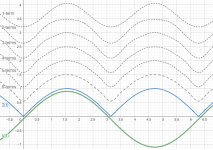RichB
Senior Member
- Location
- Tacoma, Wa
- Occupation
- Electrician/Electrical Inspector
This fits in several topics so I put it here
This came up in as discussion the other day;
My thoughts are:
No-Current does not have an inherent frequency because:
1. In an open AC circuit you can measure Voltage and Frequency but no current
2. You can change the frequency of the applied EMF at any time as it is a function of # of poles and RPM of the source
3. Current is a measurement of electrons past a given point
4. You can not change the "frequency" of current without changing the frequency of the applied EMF at the source to cause said change
With a 'scope placed on a circuit you would read the value of the current changing value in a sinusoidal manner--following the frequency of the applied EMF.
Therefore, current has no inherent frequency but its apparent frequency is driven by the frequency of the applied EMF
So, now tell me where I messed this up
Thanks All!!
This came up in as discussion the other day;
My thoughts are:
No-Current does not have an inherent frequency because:
1. In an open AC circuit you can measure Voltage and Frequency but no current
2. You can change the frequency of the applied EMF at any time as it is a function of # of poles and RPM of the source
3. Current is a measurement of electrons past a given point
4. You can not change the "frequency" of current without changing the frequency of the applied EMF at the source to cause said change
With a 'scope placed on a circuit you would read the value of the current changing value in a sinusoidal manner--following the frequency of the applied EMF.
Therefore, current has no inherent frequency but its apparent frequency is driven by the frequency of the applied EMF
So, now tell me where I messed this up
Thanks All!!





